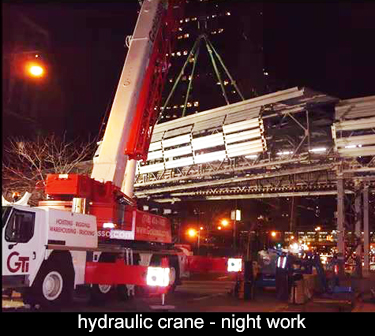I've often seen a crane of this size, or perhaps somewhat smaller, in downtown Manhattan. During the weekend, they might close the street and bring in one of these cranes and the crane can reach up to the roof of a building and, probably, for the purpose of replacing an HV AC unit up on the roof. That's it, if you need one pick and you're going to confine the activities to one day, this would be the perfect tool for that application.
 Here is a hydraulic crane being used to take down a portion of a pedestrian overpass. The roadway below It has been closed and the work is being done at night. This is, I guess I would call it a midsize hydraulic crane. It's not that small cherry picker that you see all the time. It's not the Goliath from the previous slide. This is a more normal size crane, readily available, and it was called in to do this one pick. It's the perfect tool for this. It travels to the job site at highway speeds and comes out here, extends its outriggers, and it's set up and ready to go to work in a matter of minutes.
Here is a hydraulic crane being used to take down a portion of a pedestrian overpass. The roadway below It has been closed and the work is being done at night. This is, I guess I would call it a midsize hydraulic crane. It's not that small cherry picker that you see all the time. It's not the Goliath from the previous slide. This is a more normal size crane, readily available, and it was called in to do this one pick. It's the perfect tool for this. It travels to the job site at highway speeds and comes out here, extends its outriggers, and it's set up and ready to go to work in a matter of minutes.
They assume that a crane can work in this small space, but that crane needs much more than one lane. It can fit in one lane , while it's traveling with the outriggers collapsed, but once the outriggers are extended and it's ready to make a pick, at a minimum, that would occupy two lanes and more typically, especially with a bigger machine, it really would occupy two plus lanes. So you need to keep this in mind if you're planning a special pick like this one.
Everything you need to know about cranes is available online. There are catalogs available from every manufacturer. I'm not trying to promote any one manufacturer. They are available by everyone in the industry that supplies cranes. It will give you everything you need to know; the weight of the crane, the dimensions of the crane. You need to just satisfy yourself that whatever it is you're trying to do is well within the reach of a readily available device. The illustration on the cover shows the machine on outriggers. That gives you a little better sense of the footprint that is required.
The catalogs are filled with information, probably much, much more than you really need to know, but if you are planning a special pick in a demanding environment, it could be small. It could be surrounded by other structures. You need to assure yourself that machines exist with the capacity to accomplish what you're trying to accomplish. Illustrated here is a load chart, which shows the capacity of the crane at every possible reach. In other words, as you reach further and further with the load, the load has to be reduced. All of that is defined in every possible configuration for every machine.
As designers, you don't need to get into the details, but if you're making a special pick in a challenging environment, you need to reassure yourself that machines are readily available to do what needs to be done on your project.